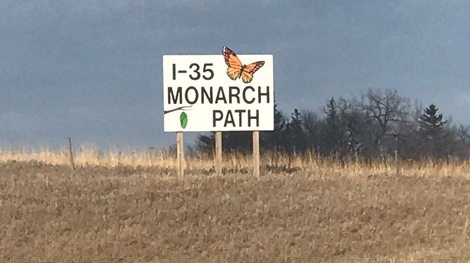“We’ve got today about seven acres of actual pollinator habitat and it’s in seven different parcels. They’re scattered here and there and of different sizes,” said Fredericks.
Fredericks conducted a profitability study on his farm in 2014 by analyzing crop yield maps spanning several years and comparing those results against the cost inputs to farm the land. The analysis helped him identify areas that did not have enough yield to justify the cost of planting. In such cases, farmers can convert low-yield cropland into pollinator habitat, which come with a multitude of benefits. Farmers can also enroll in certain federal programs that will pay them an annual rental payment for planting habitat that will improve pollinator health and have on-farm benefits such as increasing soil health.
“We tried to find maybe another option for those (low-yield) areas to improve the bottom line. And for us, it happened to coincide with a (federal) habitat initiative for monarchs,” said Fredericks. “So we put most of our (low-yield) acres into CP-42, which is the government program for monarch habitat.”
Fredericks’ farm is adjacent to I-35, the interstate dubbed the Monarch Highway because it runs along the migration corridor of the eastern monarch. According to Monarch Joint Venture, the Departments of Transportation of Minnesota, Iowa, Missouri, Kansas, Oklahoma, and Texas recognize the Monarch Highway and have initiated programs and partnerships to increase pollinator habitat.

“When we talk about the Monarch Highway, it’s engagement I think of people that live along that path. It’s not all just farmers,” said Fredericks. “We’ve got a lot of cities and small towns all along that highway that are situated there. So, it’s a great opportunity to have engagement across a broad spectrum of people.”
Fredericks notes there are few areas where habitat cannot be planted. He stresses that it will take a comprehensive effort from not only farmers but municipalities, DOTs, and the general public to develop the habitat needed to support the monarch’s population rebound. The Monarch Collaborative has written before about planting pollinator habitat on non-cropland like roadsides and septic mounds, but just about any available land can include pollinator forage such as milkweed and wildflowers.
“People in urban areas can put habitat down in grass ways, backyards, flower beds, and urban settings like parks. There’s just tremendous opportunities for places for habitat. We like to engage in that conversation both with the farmers and with the non-farmers,” said Fredericks.
To learn more about the resources and programs available to plant monarch and pollinator forage, visit the State Resources as well as the National Information pages on our website.
